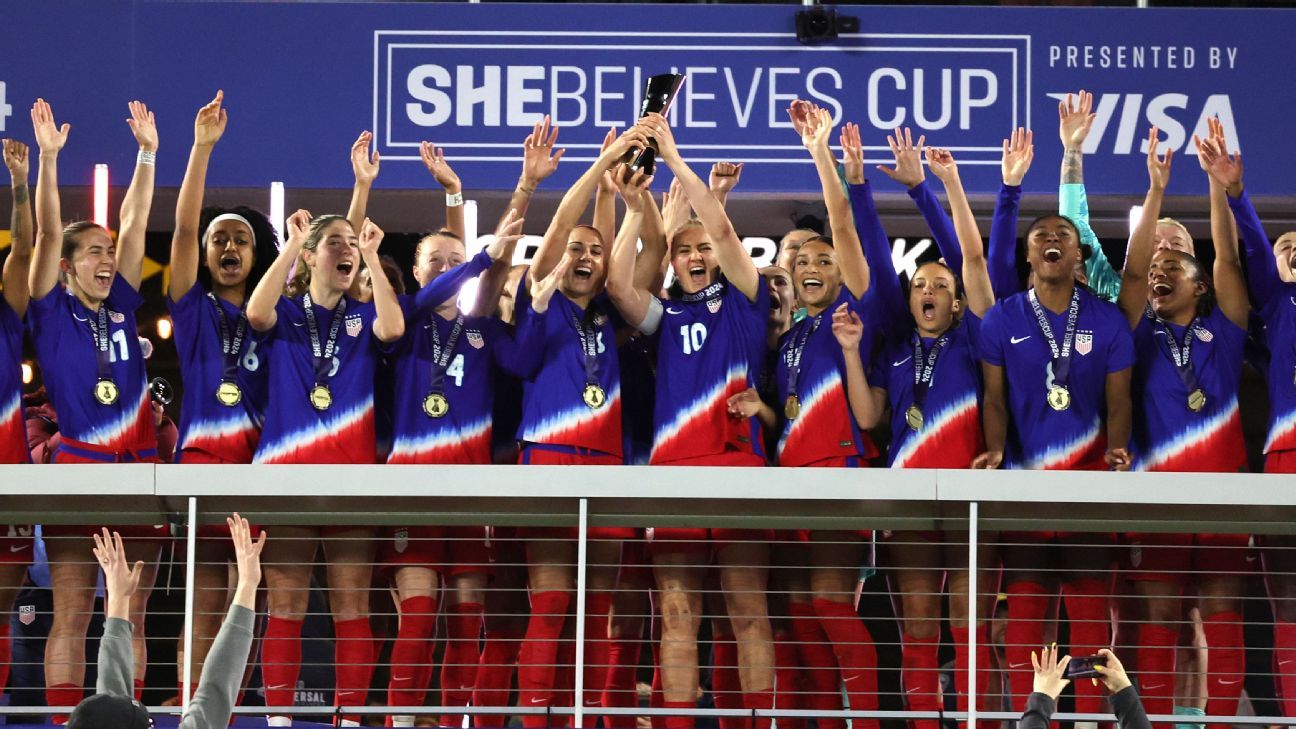COLUMBUS, Ohio — Another game United States–Canada matchup, another victorious penalty shootout for the Americans.
The USWNT defeated Canada in a shootout on Tuesday for the second time in 34 days, again after Canada equalized late in a match for a 2-2 draw. The win brought a seventh SheBelieves Cup title in nine editions of the tournament for the USWNT. While a trophy is nice, the most important aspect of the night was what did and did not work tactically as the Americans continue through this transition phase three months ahead of the Olympics.
On Tuesday, USWNT interim coach Twila Kilgore made four changes to the lineup that defeated Japan 2-1 three days earlier. The “who” of the changes was far less important than the “how,” and they captured the essence of one of the biggest questions impending head coach Emma Hayes must address upon her arrival next month: Does she try to get her most talented 11 players on the field, or will she make necessary sacrifices to find her most cohesive squad?
– Stream on ESPN+: LaLiga, Bundesliga, more (U.S.)
The pitfalls of the former approach were on display Tuesday and stood in stark contrast to a dominant USWNT performance against Japan. On Tuesday, Jaedyn Shaw moved back to a winger role after thriving in the No. 10 position against Japan. She flanked striker Alex Morgan on the left, with Sophia Smith lining up on the right. Lindsey Horan pushed higher into the No. 10 role, but the net result was a familiar problem for USWNT: several players who prefer to occupy central spaces are tasked with providing width.
Horan tended to drift toward the right side alongside Smith in the first half, presumably to allow Shaw the freedom to tuck inside. The net result, however, was that the US was left without a central passing option in the space a No. 10 would traditionally occupy. At one point late in the first half, Shaw drifted all the way to the right touchline alongside Smith to find the ball.
The problem was clear enough to require a change coming out of half-time: Mallory Swanson — likely on minutes restrictions as she returns from injury — replaced Sam Coffey, which shifted Horan deeper into midfield and Shaw inside to formally take over the No. 10 role. The changes paid off almost immediately: Smith equalized five minutes after half-time on an assist from Shaw. Eighteen minutes later, Shaw was the central playmaker again, finding second-half substitute Trinity Rodman, who fed a through ball to Smith for a second goal.
Shaw was a catalyst of the USWNT’s attack on Saturday in a convincing team performance against Japan. Swanson and Rodman ran the wings on each side of Morgan in that game, meaning the USWNT’s front four were all in their preferred and most natural positions. The USWNT looked out of sorts on Tuesday with those players shuffled, but balance was restored as soon as the half-time changes were made.
There lies the issue for Hayes — and it is a good problem to have.
If Shaw’s performances continue to command the starting No. 10 role — she certainly made that case against Japan and in the second half against Canada — and Horan shifts deeper into a No. 8 or double pivot role, what does that mean for a healthy Rose Lavelle or Catarina Macario?
And with Swanson and Rodman most comfortable in the winger roles, and Morgan continues to reassert her claim as the team’s central target, what happens to the uber talented Smith, recent NWSL MVP and Golden Boot winner? Smith is dominant in the NWSL for the Portland Thorns but has struggled to grasp hold of an exact role at the international level, in part because of this positional dilemma. It is no coincidence she scored both goals in the second half, including her second tally right after she moved to the No. 9 role.
None of these issues are new, but a different coach will now be tasked with solving them. Hayes must figure out how to optimize a talented squad.
Last year’s tepid Women’s World Cup showing from the USWNT was a product of individualistic play and a team that lacked chemistry, in part because it couldn’t figure out its identity. Smith shoehorned into a wide role with Morgan as the striker, and the U.S. rotated its midfield in search of answers for a recovering and then injured Lavelle. Those solutions came too late, and the USWNT was bounced by Sweden in a penalty shootout in the round of 16.
Hayes previously criticized the USWNT for its lack of technical players, so the evolution of Shaw into a star before her eyes before she even arrives on the sideline is a fruitful development.
Tuesday’s match reiterated that how the USWNT lines up is as important as who is on the field. There is not and never was, even through the struggles of recent years, a shortage of talent in the American player pool; there was a shortage of ideas and viable solutions — from coaches and players alike.
Hayes was hired — and worth the wait as she finishes her time at Chelsea — because U.S. Soccer feels like she is the best coach to solve those issues. She will have only a few months to do so ahead of the Olympics, but the signs of what is and is not working were on display again on Tuesday in a tale of two halves.
